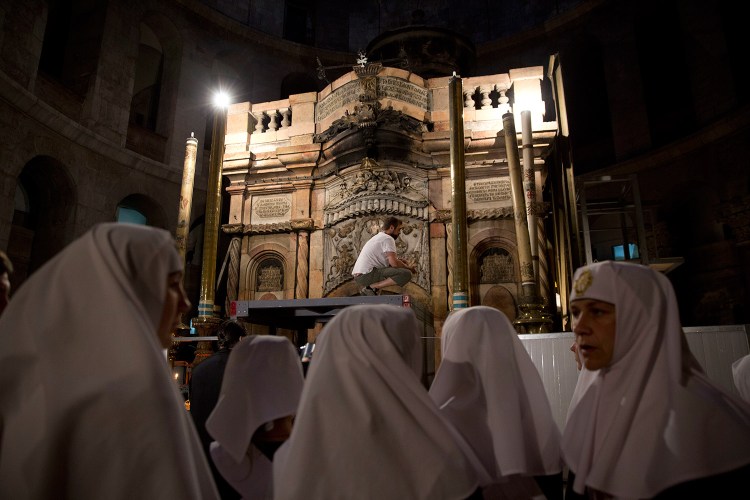JERUSALEM — A team of experts began a historic renovation Monday at the spot where Christians believe Jesus was buried, overcoming longstanding religious rivalries to carry out the first repairs at the site in more than 200 years.
The project is focused on reinforcing and preserving the Edicule – the ancient chamber housing Jesus’ tomb in Jerusalem’s Church of the Holy Sepulchre. It is the first such work at the tomb since 1810, when the shrine was restored and given its current shape after a fire.
An ornate structure with hanging oil lamps, columns and oversize candlesticks, the Edicule was erected above the spot where Christian tradition says Jesus’ body was anointed, wrapped in cloth and buried before his resurrection. It stands a few hundred yards from the site of Jesus’ crucifixion.
With its stone staircases, gilded ornamentation and many dark chambers, the church is one of Christianity’s holiest shrines. But that hasn’t stopped clerics from engaging in turf rivalries over the years.
ISRAELI POLICE SHUTDOWN
The Roman Catholic, Greek Orthodox and Armenian churches are responsible for maintaining separate sections, and each denomination jealously guards its domain. In 2008, an argument between Greek Orthodox and Armenian monks erupted into a brawl.
This time, the clergymen put aside their differences – a reflection of the dire need for the repairs. Last year, Israeli police briefly shut down the building after Israel’s Antiquities Authority deemed it unsafe, prompting the Christian denominations to join forces.
Work began late Monday, carried out by a team of nine Greek experts who have done similar restoration work on the Acropolis as well as to Byzantine churches throughout the Mediterranean.
YEARS OF EXPOSURE
Antonia Moropoulou, an architect at the National Technical University of Athens, said the tomb is stable, but needs urgent attention after years of exposure to environmental factors such as water, humidity and candle smoke.
“The marble and stone slabs have developed, due to the stresses, some deformations,” she said. The structure also needs to be protected from the risk of earthquake damage.
The project will bolster the structure by replacing the mortars and strengthening the columns. It is expected to take eight to 12 months, during which time pilgrims will be able to continue visiting the site.
COST IS SHARED
The project will cost about $3.3 million, said Theophilos III, the Greek-Orthodox patriarch of Jerusalem. Each church is contributing funds. Jordan’s King Abdullah also made a personal donation. Jordan controlled Jerusalem’s Old City until the 1967 Mideast war, and the kingdom continues to play a role safeguarding Muslim and Christian holy sites.
The church, one of the world’s oldest, was built in 325 A.D. by the Roman Emperor Constantine. That structure was destroyed in 1009 by Muslim Caliph al-Hakim. A 12th-century restoration by the Crusaders gave the Holy Sepulchre its current appearance, while in 1808 a fire all but destroyed the Edicule.
In 1852, the Ottoman authorities then governing the Holy Land provided a framework for resolving disputes inside the church.
For pilgrims like Italian Claudio Pardini, the restoration is “an important sign” that all of the Christian churches are getting together to preserve their faith’s traditions.
“It’s good to take care of our churches so that we can leave the next generations a sign, something to visit,” he said. “Because Christ isn’t an idea. He’s a story.”
Send questions/comments to the editors.



Success. Please wait for the page to reload. If the page does not reload within 5 seconds, please refresh the page.
Enter your email and password to access comments.
Hi, to comment on stories you must . This profile is in addition to your subscription and website login.
Already have a commenting profile? .
Invalid username/password.
Please check your email to confirm and complete your registration.
Only subscribers are eligible to post comments. Please subscribe or login first for digital access. Here’s why.
Use the form below to reset your password. When you've submitted your account email, we will send an email with a reset code.